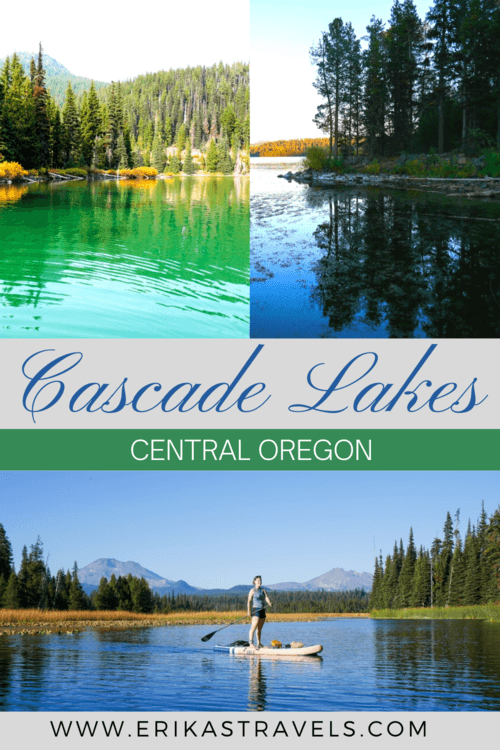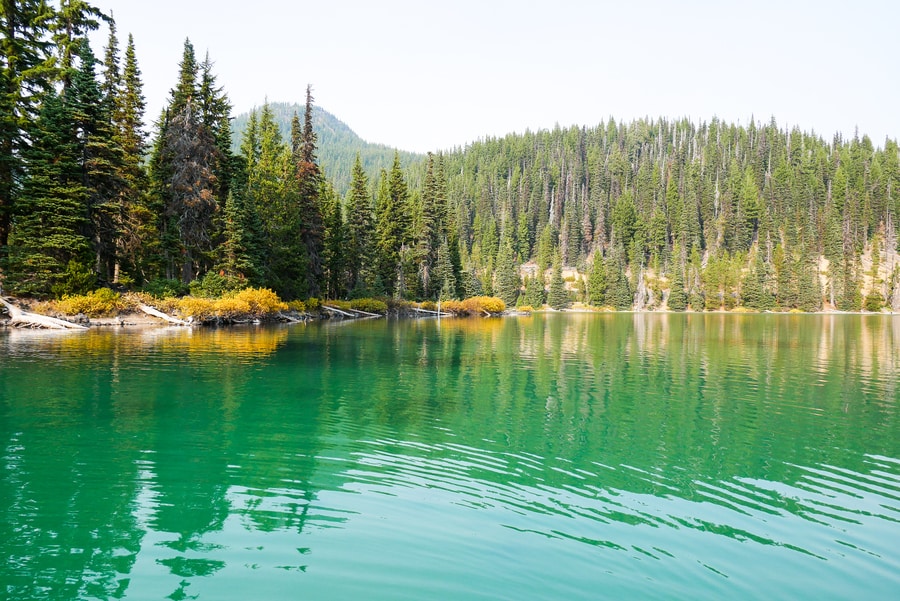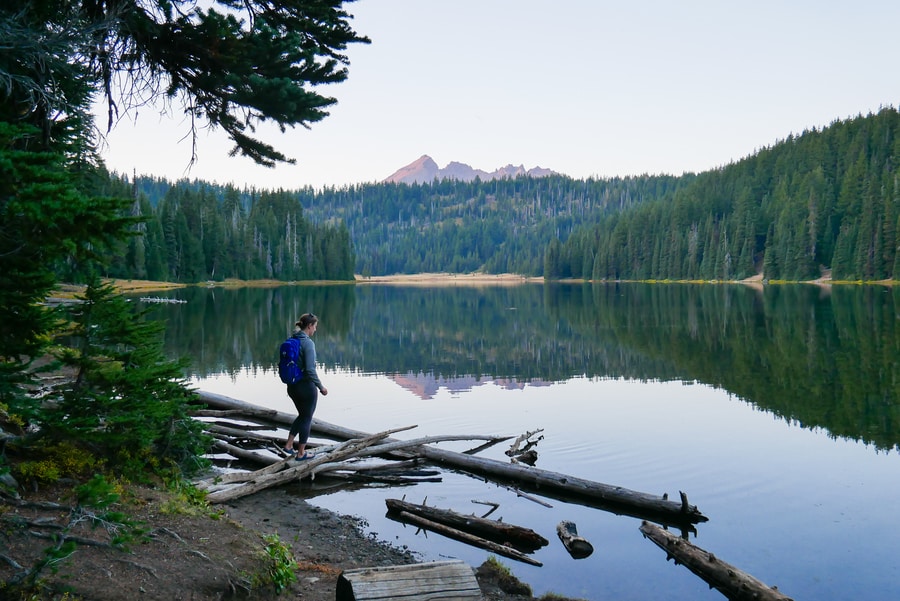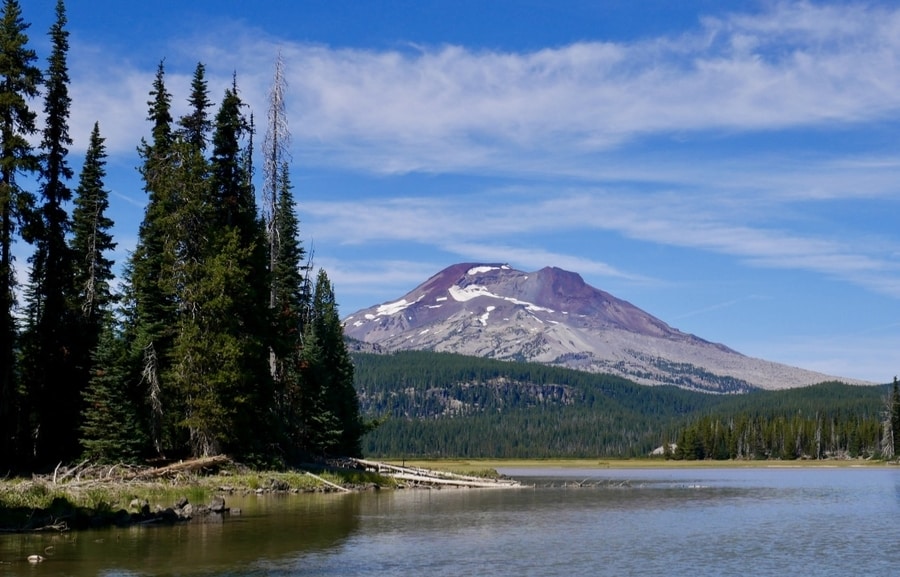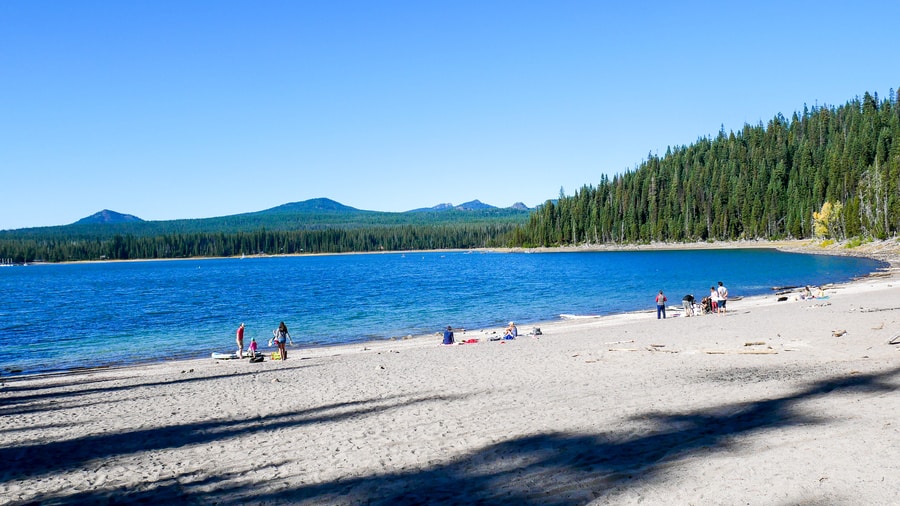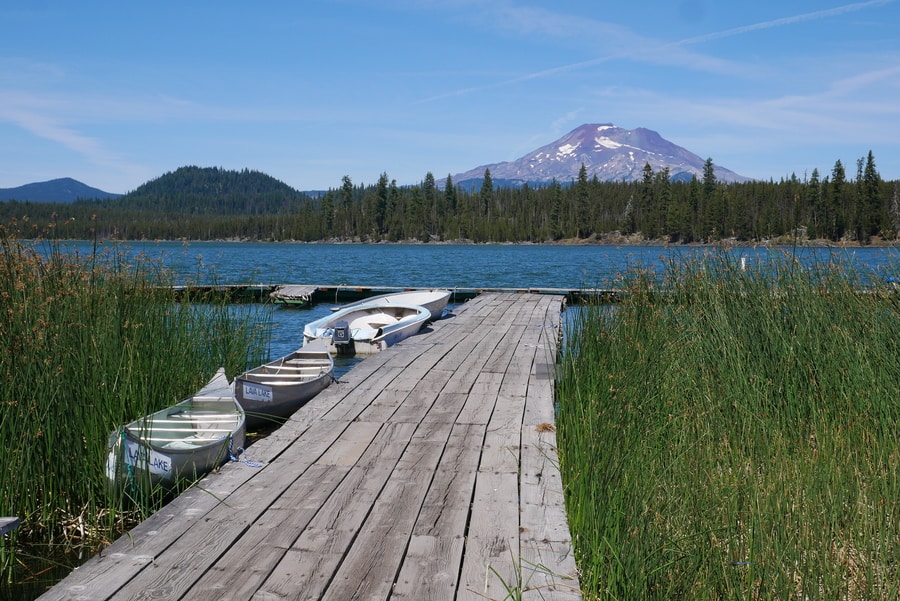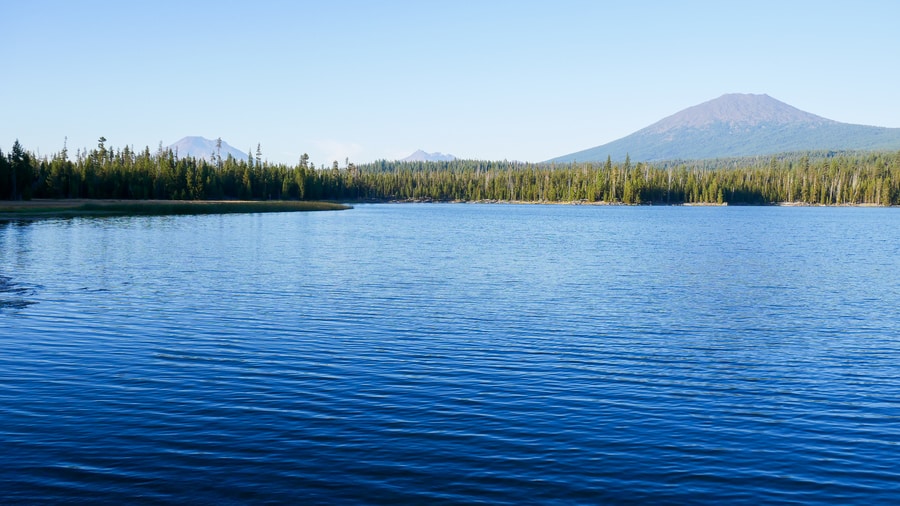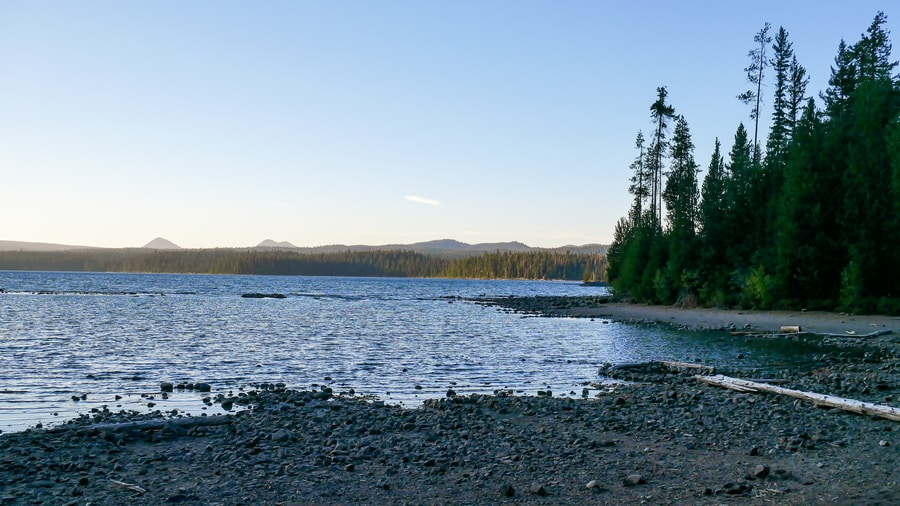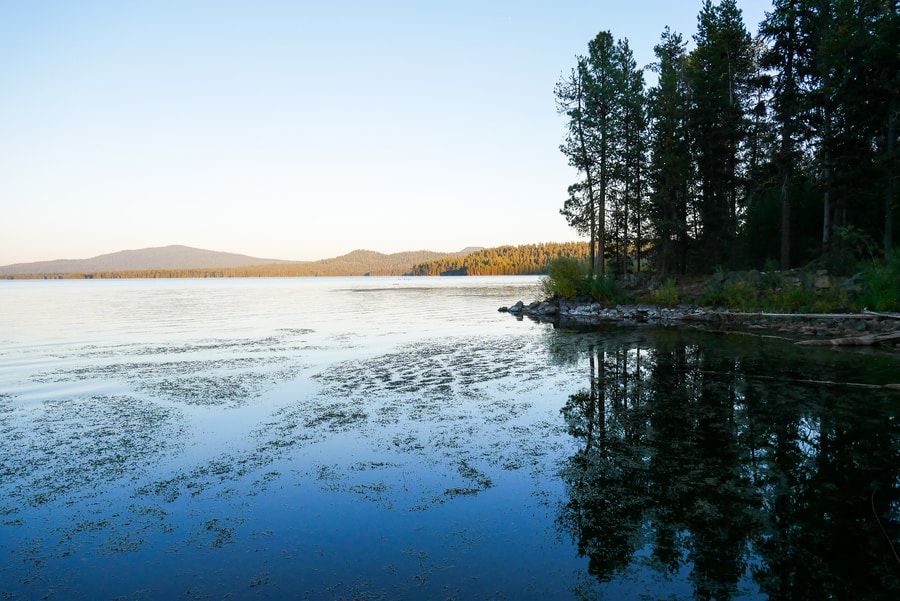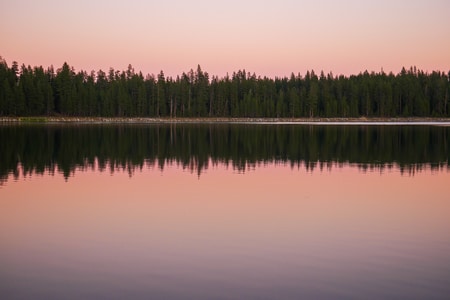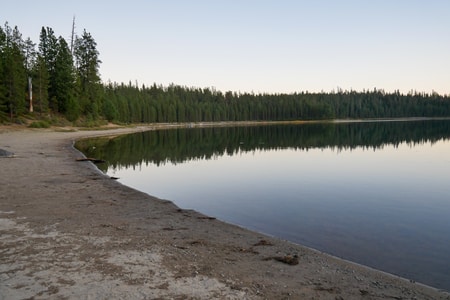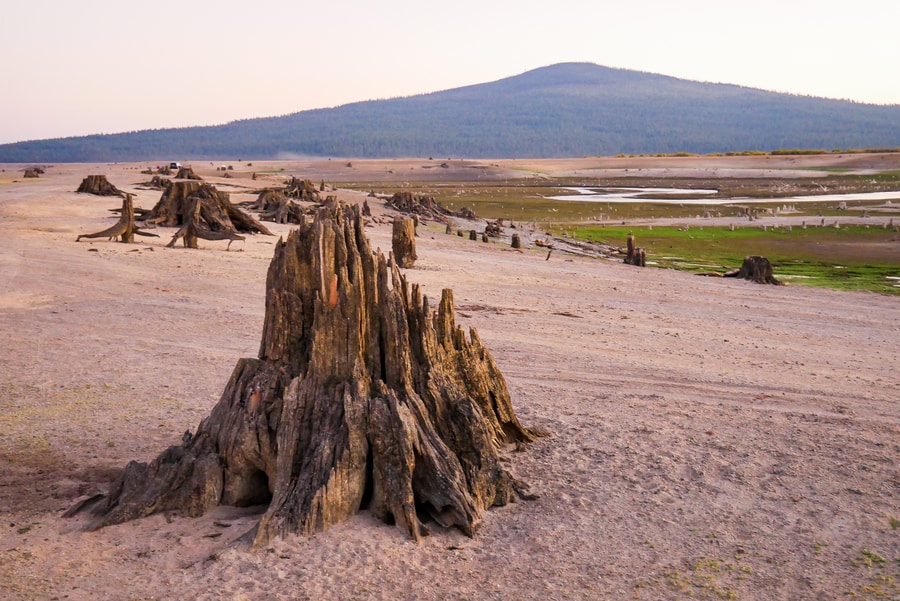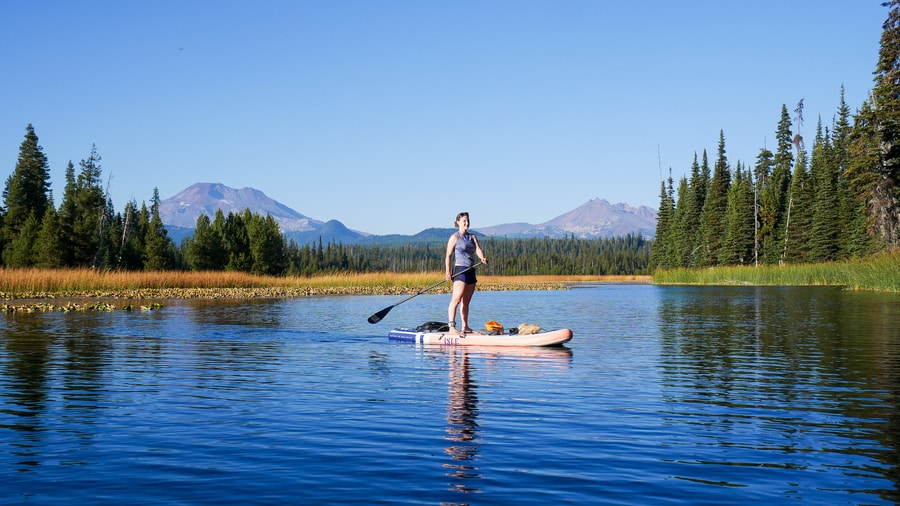
Exploring the Cascade Lakes Highway in Oregon
When it comes to natural splendor, Central Oregon is a land of plenty. It features everything an outdoor adventurer could dream of: verdant forests, towering snow-capped mountains, arid desert, and ancient lava flows.
Amongst all its alpine beauty and high desert magic, I sometimes forget that the area is a mecca for water sports as well.
But Central Oregon’s lakes and rivers are not merely an afterthought. In fact, the Cascade Lakes—a necklace of sparkling pools along the eastern edge of Central Oregon’s Cascade Mountains—are some of the state’s most alluring features.
With their forested settings and spectacular mountain backdrops, the jewel-like alpine lakes are recreational hotspots for Bendites and locals alike.
THE CASCADE LAKES SCENIC BYWAY
The Cascade Lakes Scenic Byway is a historic highway that winds its way through 66 miles of towering mountain peaks and lakefront vistas. It passes alongside the most beautiful alpine lakes in Oregon, and connects the city of Bend with Highway 58.
Scenic America considers the Cascade Lakes Highway to be among the top ten most important byways in the United States.
And, considering the glistening lakes that adorn its entire route, I can certainly see why.
The national scenic byway begins in Bend and passes through the heart of Central Oregon. Along the way, it traverses the Deschutes National Forest and provides peek-a-boo views of the towering Cascade Mountains.
After showcasing magnificent views of Mount Bachelor, Broken Top and the Three Sisters, the drive reaches Todd Lake—the first in a string of Cascade lakes that shimmer under the brilliant Central Oregon sun.
TODD LAKE
With Bend in the rearview mirror, Todd Lake is the first major water landmark along the Cascade Lakes Byway. Todd Lake lies on a potholed gravel road, about half an hour from downtown Bend. Due to its close proximity to town, it is one of the easiest high mountain lakes to access and a popular photography destination.
Todd Lake sits at an elevation of 6,150 feet, between Broken Top and Mount Bachelor. A 1.7 mile loop trail around the lake reveals spectacular views of the two mountains. The level stroll is one of the top hikes in the area.
Thanks to the fact that motorized crafts are prohibited, Todd Lake’s waters remain pristine and glassy.
I imagine it would be a wonderful place to swim, canoe, or paddle board.
SPARKS LAKE
Sparks Lake is among the most popular destinations in Central Oregon. The sprawling body of water fans out over a shallow marshy plain and showcases spectacular views of Mount Bachelor, the South Sister, and Broken Top.
Located just 25km from Bend, Sparks Lake makes for a popular day trip destination. While the lake’s parking lot can overflow on sunny weekends, its size means that paddling away from the crowds is possible even on the most congested summer days.
Kayaking Sparks Lake is extremely popular, thanks in large part to its motorboat-free waters and maze of marsh-lined channels.
For those who want to soak in the scenery of Oregon’s Cascade Lakes without setting foot in a boat, Spark Lake offers picnic areas and a fantastic little hiking trail. The Ray Atkeson Loop Trail is a 2.5 mile level hike that showcases the area’s spectacular natural setting.
DEVIL’S LAKE
Devil’s Lake lies just off the Cascade Lakes Highway, about 30 miles southwest of Bend. Like Sparks Lake, it is visible from the road and makes for a popular kayaking and paddle boarding destination.
Thanks to its shallow depths and lack of nutrients, Devil’s Lake is an exquisite turquoise color. Though the lake doesn’t boast the mountain views characteristic of Bend’s other Cascade Lakes, it lies nestled amongst ponderosa forest and age-old lava flows.
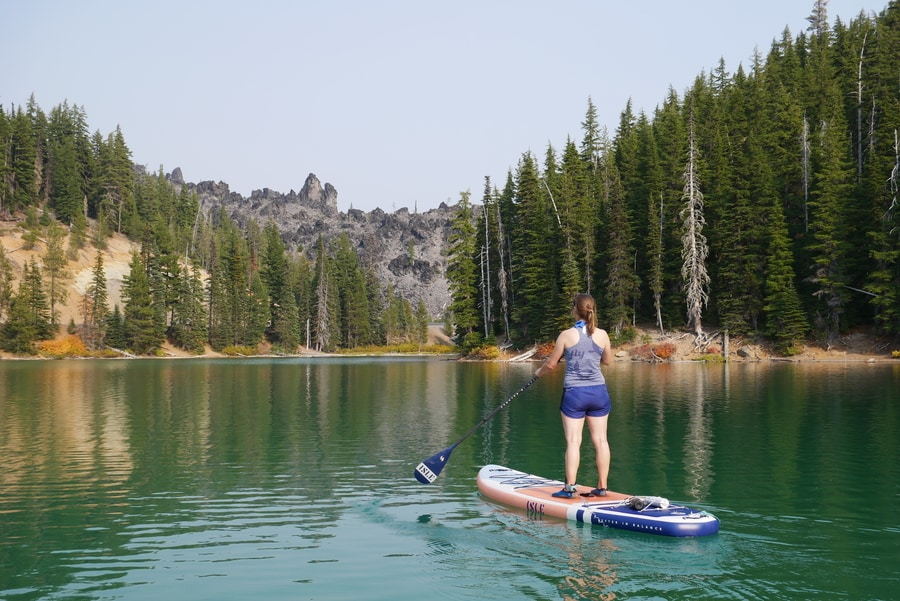
Devil’s Lake is one of the most striking lakes in all of Oregon. Its only downside is the hum of vehicle traffic from the nearby road.
ELK LAKE
Elk Lake is one of the most popular stops along the Cascade Lakes Scenic Byway. It is a one-size-fits-all lake that caters to all types of water recreation. Come summer months, it becomes a magnet for boaters and the area’s go-to place for water skiing.
Unlike some of the quieter destinations on the Cascade Lakes Highway, Elk Lake contains a resort, boat rentals and plenty of amenities.
Furthermore, Elk Lake is large and windy in comparison to other lakes in the area—making it the number one sailing destination in the central Cascades.
Although it can be crowded and resort-like at times, it is possible to find some quiet spots around Elk Lake’s shoreline. Dan and I encountered fewer crowds when we followed the gravel road to a the Sunset View Day Use Area.
On the back side of the lake, we found a wide sandy beach that was perfect for swimming, sunbathing and picnicking.
HOSMER LAKE
Hosmer Lake is a hidden turquoise gem surrounded by lush, emerald forest. It lies along a forest service road, behind Elk Lake.
While Elk Lake is known as one of the best places in the area for boating and sailing, Hosmer Lake prohibits motorized crafts and is a haven for paddlers and kayakers. Its maze-like waterways and narrow channels make it a fun place to explore.
Of all the lakes in Central Oregon, few are as enticing as Hosmer Lake. The lake has three distinct areas, all of which provide incredible views of nearby South Sister, Broken Top and Mount Bachelor.
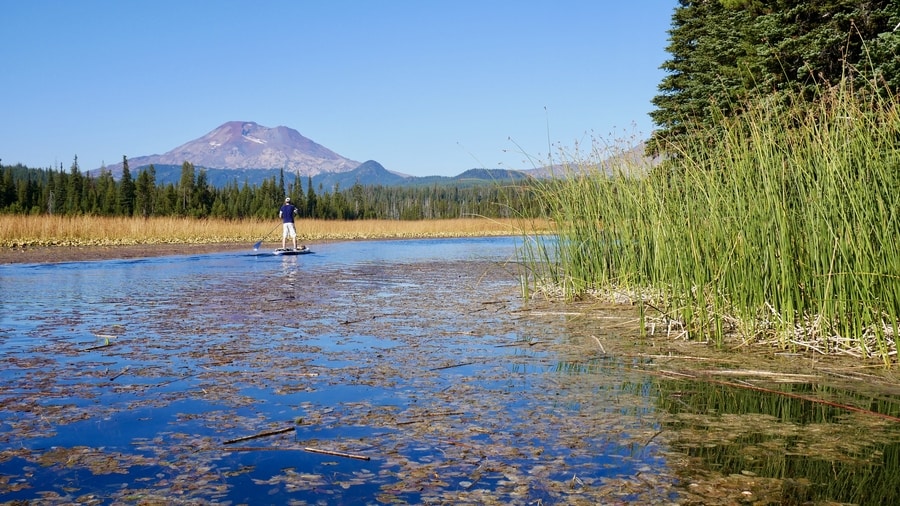
Hosmer Lake consists of two large open areas that are connected by a winding waterway. Encroaching reeds completely obscure the banks, leaving only a narrow channel. At the north end of the lake, water drains into a porous rim of lava.
Navigating the narrow channels by boat is the only real way to experience Hosmer Lake, since much of it lies hidden from sight behind tall bulrushes.
LAVA LAKE
As its name suggests, Lava Lake formed as a result of lava flows from nearby cinder cones. Solidified lava and ponderosa forest line the edges of the lake. To the north, Broken Top and South Sister puncture the horizon line.
When comparing it to the other lakes in the area, I found Lava Lake to be somewhat of a middle ground in terms of size, amenities, location, and recreational opportunities. The lake lies smack dab in the middle of the scenic byway. It is not the most crowded lake in the area, nor is it the quietest. Its calm waters allow for motorized crafts, but all boats must adhere to 10 mile an hour speed limits.
Lava Lake Resort Marina features boat rentals, an RV park with full hookups, and a basic general store. While it does not offer lodging, it has tree-line campsites that are reservable in summer.
LITTLE LAVA LAKE
Little Lava Lake lies just behind (Big) Lava Lake, in the middle of the Cascade Lakes Scenic Byway. The stunning body of water—surrounded by mature pine forests and bulrushes—is a sapphire gem that receives far less attention than its northerly neighbors.
Yet, while Little Lava Lake remains relatively off the beaten path, it is perhaps the most important of all the Cascade Lakes. For not only is the lake a scenic place to visit, but it is also the birthplace of the Deschutes River—a spectacular winding waterway that weaves through downtown Bend and is one of Central Oregon’s defining features.
Like Hosmer Lake, Little Lava Lake is known for being a scenic destination that prohibits motorized boats. Paddlers and anglers may find that it offers a quiet alternative to some of the more popular lakes in the region.
CULTUS LAKE
Tucked down a gravel road away from the main highway, Cultus Lake’s size comes as a bit of a surprise. The tree-lined lake covers an area of 1.2 square miles and is one of the largest and deepest in Central Oregon.
The natural glacier-formed lake lies approximately 48 miles southwest of Bend. It is one of the few Cascade Lakes that allows high speed motorized boats—making it a popular summertime destination for thrill-seekers, wakeboarders and jet skiers.
Like Elk Lake, Cultus Lake is a bustling boating destination that has all the amenities one would need. Its resort offers lodging facilities, a general store, dining options, and boat rentals.
LITTLE CULTUS LAKE
With the exception of its name, Little Cultus Lake is nothing like its larger counterpart. While (Big) Cultus Lake is a busy speedboating paradise, Little Cultus Lake caters to those looking for a relaxed atmosphere with fewer crowds.
Since Dan and I were trying to race the sinking sun on our drive down the Cascade Lakes Highway, we didn’t have a chance to discover Little Cultus Lake firsthand.
From my understanding, however, it is a tranquil and overlooked destination that deserves attention.
CRANE PRAIRIE RESERVOIR
The Crane Prairie Reservoir is an artificial lake that covers 3,420 acres on the Deschutes River. The reservoir gets its name from the abundance of cranes that inhabited the area’s prairies prior to the damming of the river.
Thankfully, while the creation of the lake altered the landscape permanently, the Crane Prairie Reservoir remains a haven for geese, osprey, herons, and sandhill cranes. It is a thriving wildlife habitat and a popular destination for local fishermen.
The lake’s large size and distance from Bend make it a relatively quiet place to visit.
We didn’t have much time to enjoy the Crane Prairie Reservoir. Yet, from what we could see, the lake offers an abundance of recreational and birdwatching opportunities.
Boats, kayaks, paddle boards, and canoes are available directly from Crane Prairie Resort. The family-owned resort also offers camping hookups, rustic cabins, snacks, and a tackle shop.
TWIN LAKES
The glassy waters of North and South Twin Lakes reflect the skies in near-perfect symmetry. The circular pools are a result of violent steam explosions that formed shallow craters. Over millennia, the craters have filled with water and transformed into mirror-like lakes that are perfect for swimming and paddling.
The two lakes—located less than a mile apart—are virtually indistinguishable from one another.
Since they don’t boast the incredible views of Bachelor, Broken Top, and the Three Sisters, the Twin Lakes are generally quieter destinations.
When we visited on a sunny September weekend, we saw only a handful of other people spread out across the two lakes.
Twin Lakes Resort lies on the shores of South Twin Lake. It offers a country store, RV hookups, cabins, and a restaurant.
WICKIUP RESERVOIR
Like the Crane Prairie Reservoir, the Wickiup Reservoir formed artificially as a result of the damming the Deschutes River in 1949.
Under normal circumstances, the massive 10,330 acre lake is a haven for anglers. It is dubbed the best lake for brown trout fishing in Oregon.
I would have never known of the Wickiup Reservoir’s sheer size had I relied merely on first-hand experience, however.
When Dan and I visited, extremely low water levels indicated only a small stream. With the lake’s water drained, the Deschutes River seemed to be a feeble shadow of its former self.
Unexpectedly, the dried out Wickiup Reservoir ended up being a highlight of our trip down the Cascade Lakes Highway.
We drove out onto the lakebed—past a forest of tree stumps—to an open area that overlooked the serpentine course of the remaining waterway.
When we got out to the center of the lakebed, we noticed a few people had set up camp in the area.
Had we planned accordingly, we would have loved to do the same.
DAVIS LAKE
The Cascade Lakes Scenic Byway continues south to Davis Lake—the last in a long chain of lakes that connects Bend with Highway 58.
Davis Lake formed when a large lava flow cut off Odell Creek. The lake contracts significantly in summer months, when water seepage through the porous lava rocks outpaces inflow from Odell and Ranger creeks.
Like Little Cultus Lake, we didn’t have the time to visit Davis Lake during our trip along the Cascade Lakes Scenic Byway. From my understanding, however, Davis Lake is a renowned fly fishing destination famous for its abundance of rainbow trout.
****
Central Oregon’s Cascade Lakes are showstoppers. Come summer, they attract recreation enthusiasts and provide respite from the warm desert sun.
While the Cascade Lakes all boast spectacular surroundings, they each have characteristics that make them unique. Some lakes cater to speedboats, others attract kayakers in droves. Some showcase long sandy beaches, others are marshy wonderlands suitable for birdwatching.
On a hot summer’s day, the chain of lakes becomes a magnet for thrill-lovers and relaxation-seekers alike. Along with the area’s desert, volcanoes, mountains, rivers, and forests, the Cascade Lakes solidify Central Oregon as the Pacific Northwest‘s ultimate outdoor playground.
_________________________________
Did You Enjoy This Guide to the Cascade Lakes Scenic Byway? Pin It!
